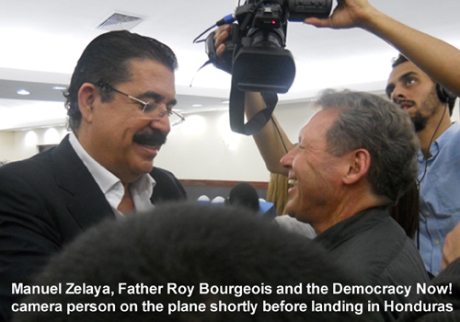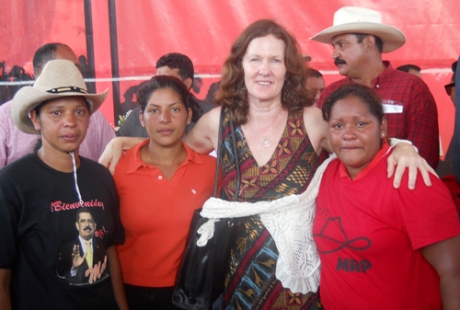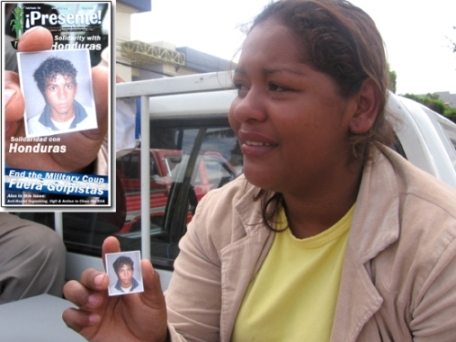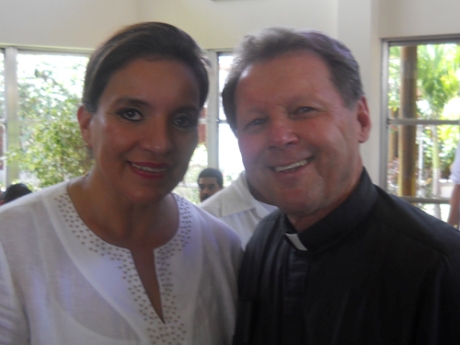
Excellent video report by Democracy Now! follows Lisa Sullivan's story
This past Saturday, Fr. Roy Bourgeois and I accompanied President Manuel Zelaya back to his native Honduras, almost two years after a military coup led by SOA graduates removed him from his country at gunpoint. The short flight we took with him, from Managua to Tegucigalpa, was a journey packed with laughter, tears, songs, nerves, hugs, and decades of history.
Above all, this was an epic Latin American journey, a brief Latin American freedom ride of sorts. It was a moment to display to a world that does not often look this way, a loosely woven cloth of Latin American sovereignty and integration. As the only U.S. citizens invited to be part of a small group of international accompaniment, Roy and I felt extraordinarily privileged to be sharing this moment with our Latin American sisters and brothers.
Zelaya’s return was made possible by an agreement brokered by the presidents of Venezuela and Colombia, to the surprise of Secretary of State Clinton, who had logged thousands of miles in her own unsuccessful efforts to negotiate this accord. Though far from being the return to his rightful place as president and only one piece of a four-point accord, the return of Zelaya and the official welcome in his country is nonetheless a significant victory.
Almost as significant as the return itself, was the form in which it was negotiated: by two nations who put aside conflicts that often seem more imposed from without than created from within. Blood brothers bound by their claim to Simon Bolivar, the Latin American liberator who was born in Venezuela and died in Colombia and dreamed of a united Latin America, these two nations unexpectedly unleashed a lightning bolt of hope that was felt the length and breadth of Latin America.
This was the emotion that dominated the group of 30 or so Latin American diplomats, ministers, social leaders and former presidents who prepared to board the plane with us in Managua. Uruguayan ambassador Julio Miguel Baraibar leaned over and whispered to me “this is not just the journey of Mel Zelaya home after a coup, it is a journey of each one of us. And, because it was negotiated by Venezuela and Colombia, it is a journey of Latin American unity”. Baraibar himself had spent over a decade in exile from his country’s military dictatorship, an experience not exclusive to him in that group.
This historical role reversal was poignantly demonstrated as Nicaragua’s President Daniel Ortega walked President Zelaya to the plane, down a red carpet spread on the runway in Managua These scene turned upside down the image that of these two countries held by those of us who remember the 1980’s, an epoch when Honduras was dubbed the “USS Honduras”. It was from Honduras that the US military trained, armed and launched the Contras into neighboring Nicaragua, shattering lives, homes and dreams of a new society. Now, Sandinista leader and current president Ortega was helping to return his neighbor’s president from Augusto Sandino International Airport, all to the tune of the Honduran national anthem played by the Nicaraguan military band lining the red carpet.
|
|
|
Mel Zelaya's wife, Xiomara and Fr. Roy Bourgeois |
Sitting just a few rows behind Zelaya and his wife, and next to their youngest daughter “La Pichu", Roy and I felt the electricity of the moment. As we lifted off, spontaneous applause broke out among observers and journalists. No sooner had reached our altitude than we began to descend. At that moment a rainbow spread out the right side of the plane’s window, above the green hills of Honduras, eliciting emotional audible sighs from the passengers. Zelaya’s wife Xiomara told me a few hours later “I couldn’t believe that I was actually in the air of Honduras and with Mel at my side.” As a leader of the strong Feminists in Resistance, Xiomara had returned many times to Honduras, but this was the first time with her husband since June 2009. She recently announced that she would be a candidate for the presidency in 2013.
As the plane began to approach the Toncantin airport suddenly a crowd of hundreds of thousands lining the airport gates became visible through the clouds, most donning red shirts. Even those in small farms dotting the landscape and on winding streets down below us looked up, waving wildly. As the plane descended, we burst into a song that we all knew too well, “De pie cantar, que el pueblo va a triunfar……“El pueblo unido jamas sera vencido!”. Descending lower and lower the chant in the airplane swelled: Venezuela: PRESENTE! El Salvador: PRESENTE! Argentina: PRESENTE! until each of our countries had been named. Finally: Honduras PRESENTE! That cheer was punctuated by massive cheers from the crowd that rose above the screech of the brakes.
I later learned from a Venezuelan official that the current Honduran Lobo regime informed him at the last minute that only President Zelaya’s family and the Venezuelan minister would be allowed to get off the plane. However, journalists were the first to hustle off the plane, immediately setting up their cameras to film those descending. With images being shown on television channels around the globe, it apparently wasn’t a very good moment to send us back on the plane.
After kissing the ground and sweeping his mother and grandson into his arms, Zelaya took the wheel of an SUV while the rest of us packed into a few vehicles, literally hanging out the windows. It felt like Zelaya couldn´t get too quickly to the crowds that awaited him almost like a messiah. We sped to the road lined by hundreds of thousands of wildly cheering, red shirted Hondurans, shouting “Si se pudo! Si se pudo!” (Yes we could!). Over and over and louder and louder, an affirmation that the bravery of the resistance movement was what really made possible this deal.
After the almost impossible task of making our way through pressed flesh and up to the stage, Roy and I clung to the edges, the appropriate place to be as two North Americans, as Zelaya and other Latin American leaders took center stage. With the encouragement of Zelaya, over and over the crowd’s reiterated the scene on the airplane, but with a twist. They shouted: Brazil, gracias!, Venezuela, gracias! Dominican Republic, gracias! and so on and so forth. This moment of sheer joy written on the faces of so many Hondurans in that sea of red , was brought to you exclusively by Latin America.
I wish I could end this report on that note. After 34 years in Latin America, a continent that I so dearly love, and whose roads and mountains and homes and hearts I have traversed and collected so much pain and so much courage, I want to end on this upbeat note of triumph. But, the back of the stage was a different scene, one that reflects the reality of Honduras behind the floodlights.

Lisa Sullivan of SOA Watch with the sisters and niece of Isis Obed Murillo, the young teenager who was shot down as he waited with hundreds of thousands on June 5, 2009 when Zelaya attempted to return and military tanks were sent to block the runway.
Suddenly thrust into my arms were three weeping women, the sisters and niece of Isis Obed Murillo, the young teenager who was shot down as he waited with hundreds of thousands on June 5, 2009, as Zelaya attempted to return and military tanks were sent to block the runway. The stage were Zelaya was speaking at that moment was at he newly baptized “Isis Obed Murillo plaza”. While Zelaya acknowledged the sacrifice of Isis and so many others in the Resistance movement whose courage and determination and refusal to give up made this moment possible, Zelaya was here while Isis was gone forever.
More worrisome is that Isis is not alone. Over 100 Hondurans have lost their lives in the struggle for justice, including dozens in the past months alone, as we learned first hand in a recent visit to Honduras’s Aguan valley. In the back edges of the stage were several key Resistance leaders and the looks on their faces were bittersweet. Berta Caceres of COPIN embraced me, while at the same time telling me with pain “Lisa, today they are militarizing the Aguan”.

Photo of Isis Obed Murillo on the cover of Fall 2009 issue of Presente
This week Honduras might briefly pop up again in your local paper when it is probably accepted back into the Organization of American States, one of the reasons motivating the timing of the return of Zelaya. But then, expect Honduras to once again disappear from the front sections of all major international newspapers.
But, pay attention to two things that you might miss. A month after the OAS meeting, the new CELAC, the Community of Latin American and Caribbean States will be inaugurated in Venezuela. Comprised of all the nations of the Americas, except the U.S. and Canadian, this new body reflects the growing integration we witnessed so dramatically on this trip and the exclusion of the U.S. is not by chance.
But also pay attention to the edges in Honduras. The lives of teachers, journalists, farmers, human rights activists and Resistance leaders outside the floodlights, rolling up their sleeves with the grueling and treacherous task of building a truly democratic nation. SOA Watch celebrates with the people of Honduras and the people of Latin America this wonderful moment, honors the privilege of being present, but above all, we continue to commit to walk with the people of Honduras while international eyes turn away.
Source: SOA Watch
